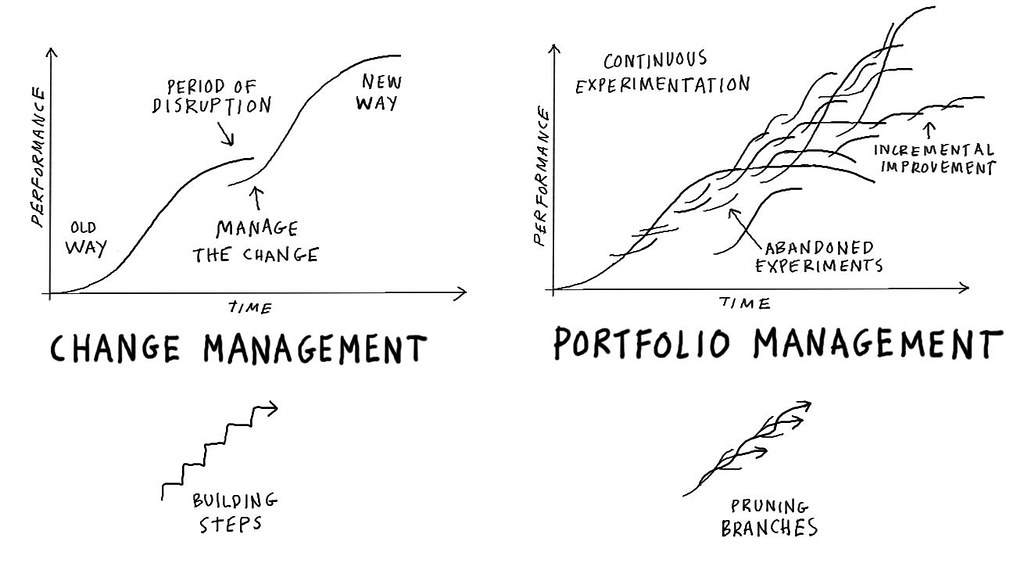Background
The New York State and Local Retirement System (NYSLRS) undertook a major system modernization effort to transition from its legacy Mainframe (MEBEL) platform to a PeopleSoft-based retirement administration system. Following the conclusion of the Accenture-led Redesign project, the organization faced significant operational disarray. With over 16 functional bureaus — including Accounting, Disability, Legal, Employer Reporting, and Pension Payroll — decentralized efforts began to emerge, lacking prioritization, coordination, or alignment to enterprise objectives.
Challenge
The absence of a centralized governance model led to:
- Disjointed initiative intake across bureau-specific PODs (Product-Oriented Delivery teams)
- Redundant or conflicting project starts without formal business justification
- Lack of visibility into active, deferred, or strategic portfolios
- Ineffective resource allocation and dependency clashes
- Failure to prioritize high-impact projects tied to legal mandates or calendar events (e.g., 1099-R processing, Legislative changes)
Objective
As Portfolio Manager (PfMP), the mission was to reestablish strategic control over the initiative pipeline, enforce governance discipline, and optimize the portfolio for value delivery, risk mitigation, and operational stability.
Strategic Solution
To address systemic fragmentation and foster enterprise portfolio management maturity, the following solutions were implemented:
- Formation of a Division Governance Board Partnered with the Executive Management Team (EMT) and PMO to institutionalize a formal portfolio governance structure, with oversight authority for investment decision-making..
- Standardized Intake Framework: Implementation of an Intake and Evaluation Framework Introduced a standardized project intake process requiring:
- Business Case submission
- Preliminary assessments with cost, benefit, and risk considerations
- Change Management Requests (CMRs)
- Architecture & Technical Standards Review
- BSA-POD coordination and Bureau prioritization
- System Change Management Committee (SCMC): Cross-functional body to review and triage requests.
- BSA-POD Leads
- AppDev Managers
- Test Managers
- Subject Matter Experts
- PMO Project Managers
- Portfolio Categorization & Prioritization Model Projects classification into four groups
- 1. Production & Operational Support (critical issues impacting stability)
- 2. Business Calendar–Driven Initiatives (e.g., 1099-R, MAS, PeopleSoft upgrades)
- 3. Strategic & Legislative Initiatives (e.g., State Enhanced Reporting)
- 4. Enhancements and Wish-List Requests
This categorization enabled value-based decision-making and dependency-aware planning.
- Integration of Bureau Priority Mechanism Revived a previously siloed bureau-driven ranking system, ensuring business units could voice priorities, while governance bodies reviewed feasibility and alignment.
This group triaged proposals, aligned them with strategic goals, and recommended items for full assessment.
Results
- Improved Portfolio Visibility: Introduced dynamic reporting of Active, Deferred, and Rejected initiatives to guide resource planning.
- Reduced Project Fragmentation: Improved collaboration between PODs, reducing project collisions and duplicate efforts.
- Enhanced Strategic Alignment: 100% of projects reviewed against organizational goals, technical feasibility, and capacity planning.
- Improved Decision Velocity: Reduced governance turnaround time for project approval by ~40% through upfront filtering at SCMC level.
- Optimized Resource Allocation: Enabled accurate forecasting for Design, Build, SIT, and UAT stages across cross-functional teams.
Key Takeaways
- A well-defined portfolio governance framework is critical post-system transformation to maintain control over enterprise investments.
- PfMP practices such as benefits realization, value scoring, and portfolio optimization must be institutionalized early to manage complexity across large public sector organizations.
- Engagement with strategic stakeholders and empowerment of cross-functional teams builds organizational trust and execution readiness.

